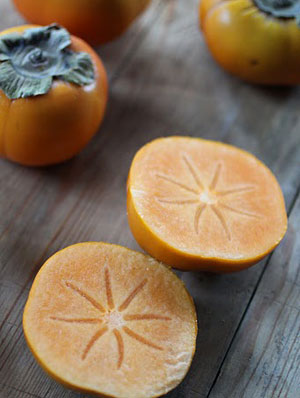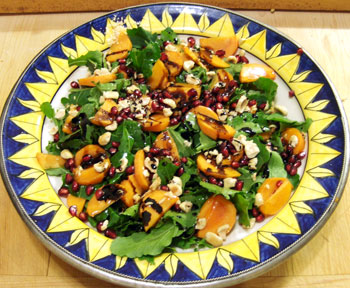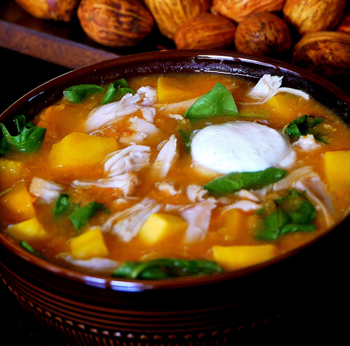 Prominent throughout the Deep South and up through Virginia to Connecticut and back down towards Florida and west to Kansas and Texas, the common Persimmon, Diospyros virginiana, makes for a Farmer’s favorite with its growth habit, bark, leaf shape, and fruit color…that fabulous color holding the rank somewhere between terra cotta, salmon, apricot, and orange.
Prominent throughout the Deep South and up through Virginia to Connecticut and back down towards Florida and west to Kansas and Texas, the common Persimmon, Diospyros virginiana, makes for a Farmer’s favorite with its growth habit, bark, leaf shape, and fruit color…that fabulous color holding the rank somewhere between terra cotta, salmon, apricot, and orange.
“Don’t you EVER bite into a green persimmon…it will turn your mouth INSIDE OUT!!!” That is what Grandmother, Mimi’s grandmother, my great, great grandmother would exclaim about this fruit. Tart and sour, the unripe persimmons are about as useful as a boar’s teat, but the ripe persimmons are lovely, flavorful, and quite delicious. “They’ve got to be DEAD ripe,” according to the grand dame Mimi herself.
Because of their extreme astringency, the persimmon will most often make you pucker, but once the sour cells within the fruit are “bletted" or partially rotted the fruit becomes much more palpable. Killed by cold, the astringent cells actually rot somewhat and cause the fruit to take on a sweeter flavor, and, thus, the old adage that persimmons are not ripe until the first frost. There is a whole chemistry lesson here but I shan’t attempt to explain the how’s and why’s – just know persimmons most often become ripe after the first frost.
 I love rustic or “free-form” tarts. This recipe makes two perfect tarts and can be filled with just about any type of firm fruit – apples, pears, peaches, nectarines or plums – whatever is in season. I used Arrowhead Mills Organic Whole Grain Pastry flour and it gives the crust a perfectly tender, flaky, buttery crust.
I love rustic or “free-form” tarts. This recipe makes two perfect tarts and can be filled with just about any type of firm fruit – apples, pears, peaches, nectarines or plums – whatever is in season. I used Arrowhead Mills Organic Whole Grain Pastry flour and it gives the crust a perfectly tender, flaky, buttery crust.
 One night last week Jeff came home from work and handed me a bag from his clinic. I thought, "Yes! More free anti-wrinkle cream!" (Having a dermatologist as a husband does have its advantages). When I peeked inside the bag, however, I discovered something even better than antioxidant cream: a dozen plump, brilliant green figs that were beginning to split from ripeness. "Wow! Where did you get the fresh figs?" I asked. "Adel gave them to me from the tree in her yard," he said.
One night last week Jeff came home from work and handed me a bag from his clinic. I thought, "Yes! More free anti-wrinkle cream!" (Having a dermatologist as a husband does have its advantages). When I peeked inside the bag, however, I discovered something even better than antioxidant cream: a dozen plump, brilliant green figs that were beginning to split from ripeness. "Wow! Where did you get the fresh figs?" I asked. "Adel gave them to me from the tree in her yard," he said. Sometimes lettuce is just not good enough. With its peppery spiciness, arugula has a refreshing bite. In Southern California, even though it gets cold in the Winter, arugula thrives in the year-round sunshine, so we're able to buy fat bunches any time of the year for $1.00/bunch.
Sometimes lettuce is just not good enough. With its peppery spiciness, arugula has a refreshing bite. In Southern California, even though it gets cold in the Winter, arugula thrives in the year-round sunshine, so we're able to buy fat bunches any time of the year for $1.00/bunch. Even though summer is considered the pinnacle of tomato season, in many parts of the country the last fall harvest before the first hard frost brings some of the tastiest and meatiest fruits to market.
Even though summer is considered the pinnacle of tomato season, in many parts of the country the last fall harvest before the first hard frost brings some of the tastiest and meatiest fruits to market. Prominent throughout the Deep South and up through Virginia to Connecticut and back down towards Florida and west to Kansas and Texas, the common Persimmon, Diospyros virginiana, makes for a Farmer’s favorite with its growth habit, bark, leaf shape, and fruit color…that fabulous color holding the rank somewhere between terra cotta, salmon, apricot, and orange.
Prominent throughout the Deep South and up through Virginia to Connecticut and back down towards Florida and west to Kansas and Texas, the common Persimmon, Diospyros virginiana, makes for a Farmer’s favorite with its growth habit, bark, leaf shape, and fruit color…that fabulous color holding the rank somewhere between terra cotta, salmon, apricot, and orange.
